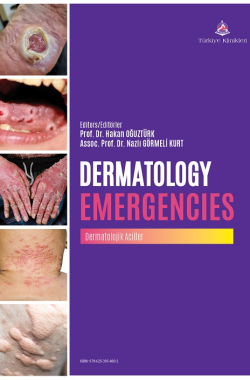Staphylococcal Scalded Skin Syndrome
Songül DOĞAN ARAÇ
University of Health Sciences Faculty of Medicine, Gazi Yaşargil Training and Research Hospital, Department of Emergency Medicine, Diyarbakır, Türkiye
Remzi ÇETİNKAYA
University of Health Sciences Faculty of Medicine, Gazi Yaşargil Training and Research Hospital, Department of Emergency Medicine, Diyarbakır, Türkiye
Doğan Araç S, Çetinkaya R. Staphylococcal scalded skin syndrome. In: Oğuztürk H, Görmeli Kurt N, eds. Dermatologic Emergencies. 1st ed. Ankara: Türkiye Klinikleri; 2025. p.75-9.
ABSTRACT
Staphylococcal Scalded Skin Syndrome (SSSS) is a disease caused by exotoxin-producing strains of Staphylococcus species, characterized by peeling of the skin. Although it is rarely seen in children over the age of six, it typically occurs within the first 48 hours of life. Additionally, it can also be seen in immunocompromised adults or patients with severe renal failure. The pathogenesis of the dis- ease is based on the cleavage of the desmoglein-1 protein by exotoxins, leading to intraepidermal desquamation. SSSS presents with widespread rashes and severe clinical symptoms due to the systemic spread of toxins.
Keywords: Erythema; blister; staphylococcal skin infections; infant, newborn, diseases
Kaynak Göster
Referanslar
- Brazel M, Desai A, Are A, Motaparthi K. Staphylococcal scalded skin syndrome and bullous impetigo. Medicina. 2021;57(11):1157. [Crossref] [PubMed] [PMC]
- Hubiche T, Bes M, Roudiere L, Langlaude F, Etienne J, Del Giudice P. Mild staphylococcal scalded skin syndrome: an underdiagnosed clinical disorder. Br J Dermatol. 2012;166(1):213-5. [Crossref] [PubMed]
- Mishra AK, Yadav P, Mishra A. A systemic review on staphylococcal scalded skin syndrome (SSSS): a rare and critical disease of neonates. Open Microbiol J. 2016;10:150-9. [Crossref] [PubMed] [PMC]
- Leung AK, Barankin B, Leong KF. Staphylococcal-scalded skin syndrome: evaluation, diagnosis, and management. World J Pediatr. 2018;14:116-20. [Crossref] [PubMed]
- Neubauer HC, Hall M, Wallace SS, Cruz AT, Queen MA, Foradori DM, et al. Variation in diagnostic test use and associated outcomes in staphylococcal scalded skin syndrome at children's hospitals. Hospital Pediatrics. 2018;8(9):530-7. [Crossref] [PubMed] [PMC]
- Mockenhaupt M, Idzko M, Grosber M, Schöpf E, Norgauer J. Epidemiology of staphylococcal scalded skin syndrome in Germany. J Investigative Dermatol. 2005;124(4):700-3. [Crossref] [PubMed]
- Patel S, Cadwell JB, Lambert WC. Comparison of adult vs. paediatric inpatients with staphylococcal scalded skin syndrome: a retrospective database analysis. Br J Dermatol. 2021;184(4):767-9. [Crossref] [PubMed]
- Lipový B, Brychta P, Chaloupková Z, Suchánek I. Staphylococcal scalded skin syndrome in the Czech Republic: an epidemiological study. Burns. 2012;38(2):296-300. [Crossref] [PubMed]
- Staiman A, Hsu DY, Silverberg JI. Epidemiology of staphylococcal scalded skin syndrome in US children. Br J Dermatol. 2018;178(3):704-8. [Crossref] [PubMed]
- Smith J, Sandall M. Staphylococcus Scalded Skin Syndrome in the newborn: A case review. J Neonatal Nursing. 2012;18(6):201-5. [Crossref]
- Lamand V, Dauwalder O, Tristan A, Casalegno JS, Meugnier H, Bes M, et al. Epidemiological data of staphylococcal scalded skin syndrome in France from 1997 to 2007 and microbiological characteristics of Staphylococcus aureus associated strains. Clin Microbiol Infect. 2012;18(12):E514-E21. [Crossref] [PubMed]
- Handler MZ, Schwartz RA. Staphylococcal scalded skin syndrome: diagnosis and management in children and adults. J Eur Acad Dermatol Venereol. 2014;28(11):1418-23. [Crossref] [PubMed]
- Ladhani S. Recent developments in staphylococcal scalded skin syndrome. Clin Microbiol Infect. 2001;7(6):301-7. [Crossref] [PubMed]
- Kadam S, Tagare A, Deodhar J, Tawade Y, Pandit A. Staphylococcal scalded skin syndrome in a neonate. Indian J Pediatr. 2009;76(10):1074. [Crossref] [PubMed]
- Farrell AM. Staphylococcal scalded-skin syndrome. Lancet. 1999;354(9182):880-1. [Crossref] [PubMed]
- Gökçeoğlu E, Körkoca H. Stafilokoksik Haşlanmış Deri Sendromu. Muş Alparslan Üniversitesi Fen Bilimleri Dergisi. 2013;1(2):127-36. [Link]
- Uzun S, Durdu M. The specificity and sensitivity of Nikolskiy sign in the diagnosis of pemphigus. J Am Acad Dermatol. 2006;54(3):411-5. [Crossref] [PubMed]
- Savaş Y. Sık Görülen Bakteriyel Deri İnfeksiyonları. Turkderm. 2011;45(2):104-8. [Crossref]
- Ross A, Sathe NC. Staphylococcal Scalded Skin Syndrome. [Updated 2024 Oct 6]. In: StatPearls [Internet]. Treasure Island (FL): StatPearls Publishing; 2024 Jan-. Available from: [Link]
- Patel GK, Finlay AY. Staphylococcal scalded skin syndrome: diagnosis and management. Am J Clin Dermatol. 2003;4:165-75. [Crossref] [PubMed]
- Amagai M, Stanley JR. Desmoglein as a target in skin disease and beyond. Journal of Investigative Dermatology. 2012;132(3):776-84. [Crossref] [PubMed] [PMC]
- Blyth M, Estela C, Young AE. Severe staphylococcal scalded skin syndrome in children. Burns. 2008;34(1):98-103. [Crossref] [PubMed]
- Hultén KG, Kok M, King KE, Lamberth LB, Kaplan SL. Increasing numbers of staphylococcal scalded skin syndrome cases caused by ST121 in Houston, Texas. Pediatr Infect Dis J. 2020;39(1):30-4. [Crossref] [PubMed]
- Urata T, Kono M, Ishihara Y, Akiyama M. Adult staphylococcal scalded skin syndrome successfully treated with multimodal therapy including intravenous immunoglobulin. Acta Derm Venereol. 2018;98(1):136-7. [Crossref] [PubMed]
- Shi D, Ishii S, Sato T, Yamazaki H, Matsunaga M, Higuchi W, et al. Staphylococcal scalded skin syndrome in an extremely low-birth-weight neonate: Molecular characterization and rapid detection by multiplex and real‐time PCR of methicillin-resistant Staphylococcus aureus. Pediatrics International. 2011;53(2):211-7. [Crossref] [PubMed]
- Braunstein I, Wanat KA, Abuabara K, McGowan KL, Yan AC, Treat JR. Antibiotic sensitivity and resistance patterns in pediatric staphylococcal scalded skin syndrome. Pediatr Dermatol. 2014;31(3):305-8. [Crossref] [PubMed] [PMC]

